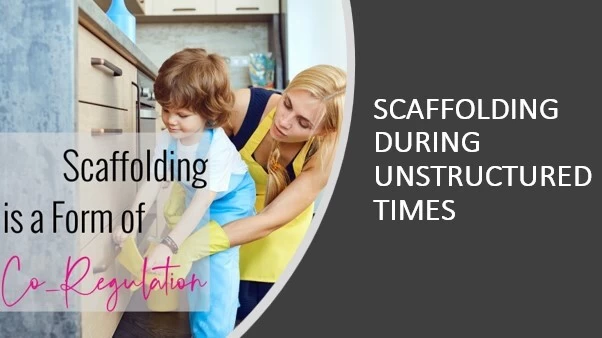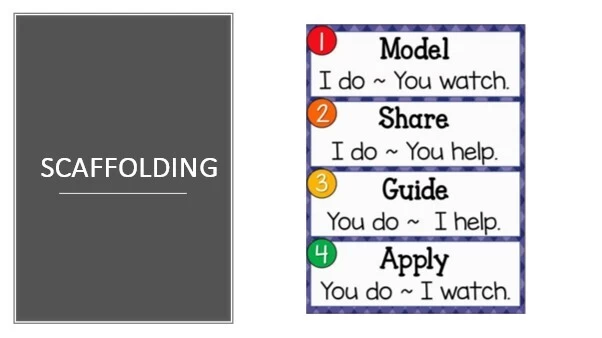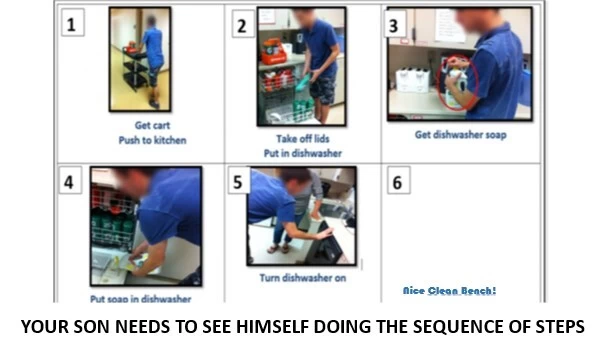
Kids need to be taught to deal with boredom
- People with ADHD have significant difficulty tolerating boredom.
- We need to teach our kids that boredom is part of life, and it is their job to learn how to deal with boredom in a way that is expected for their age.
- When kids are bored and start acting out, parents often overlook the fact that their child may need more scaffolding because they’re caught up in the behaviors and/or playing “armchair therapist”.
- Remember, you scaffold better behavior. Do not expect your son to behave better if he’s lacking scaffolding.
- Use the clock if your son has a propensity to not stick with one activity for very long. Have realistic expectations of how much time can be sustained on a given activity, with the intention of pushing it longer slowly and gradually (10 min to 11 minutes, than 12 minutes, etc.
- Give specific, limited options for what he can do. Don’t ask, tell him.
- Use very specific language to create scaffolding.
- Incentivize sustaining attention to one activity without unwanted behaviors with consistent purposeful recognition and praise.
- Many behavior issues occur due to lack of scaffolding at home.
- Limit choices to 2, do not say “go find something to do”.
- Use language of accountability if he is being inflexible or if the behaviors continue.
- Be realistic about how long he can entertain himself with one activity.
- Remember: Creating scaffolding during unstructured times is teaching self-regulation skills and tolerating boredom, one of the most important life skills.
Lack of scaffolding during unstructured times
- The younger they are, the more kids need “scaffolding” during unstructured time. This could also be applicable to kids with a more hyper/impulsive profile.
- They have difficulty visualizing what they can be doing which rapidly leads to boredom. Boredom leads to unwanted behaviors (like picking bark off your nice tree)
- Scaffolding means limiting options and giving them clear directions on what they can be doing during a given time frame. (Remember clear, concise and concrete)
- Remember that saying “Go outside for 10 minutes” is abstract because your child with ADHD does not experience time the same way you do
Set realistic expectations
- Your expectations must be congruent with how much time he can do something, keeping in mind that we want to incrementally increase tolerance for sustaining attention for something.
- You can and should slowly expand your expectation. As an example, if you know he can only handle 10 minutes of Lego time, expand it to 11 minutes, then 12 minutes eventually.
Strategies for scaffolding unstructured times
- Use the clock to help “see” time.
- Be very specific in your language. Saying “go play outside” or “find something to do” is too vague.
- Limit options, give no more than 2-3 choices for activities.
- Be very specific about what are options/not options.
- Be realistic about how much time they can do any activity to begin with, and how easily you can redirect back to the activity if they get bored/off-task.
This is how it sounds
- Here’s what the morning looks like, you can play with Legos or color in Minecraft coloring book. We’ll color in the clock so you can see what time looks like. If you want to go over the time that’s OK.
- If you can play with Legos or color during the time on the clock without bothering your sister, you can watch one Minecraft YouTube video when you’re done. If you decide to bother your sister, then you decide not to watch your video.
How it sounds with middle school
- “When we get home your choices are basketball or read. There is no Xbox until after dinner. If you choose to start complaining about Xbox, you are choosing to take your Xbox time away. If you can stick with those activities before dinner, you can have extra 10-minutes of Xbox time.”
- “When we get home, I have work phone calls to make. Your choices are Netflix until dinner or go outside. Phone or Switch are not choices until after dinner, which will be ready at 6:40
WHAT TO DO – EXTREMELY IMPORTANT
Purposeful praise and recognition for:
- Sustaining attention
- Playing quietly/occupying himself
- Not provoking/interrupting
- Not whining/complaining
Trouble shooting
- When negative behaviors have be reinforced with attention on frequent basis, it can take a long time for this dynamic to change.
- Your undivided attention may hold more weight than any incentive.
- Are your expectations incongruent with his executive functioning age? (This is something I commonly see in families)
- Are you able to make 1:1 time? I always suggest 1:1 time at bedtime, particularly for fathers.
- Siblings provoking each other is normal, parents sometimes loose sight of that. What differs for kids with ADHD is the frequency of provocation.
- The solution: provide meaningful incentives more frequently. Once you have success with this you start gradually stretching out the time frame.
- “If you can play for the amount of time we colored in the clock and not say or do anything to upset your brother, you can have one YouTube video when your time is up”.
Questions to ask yourself:
- Are you asking or telling him what to do or suggesting? Kids with ADHD often do better with being told, it is authoritative which is clearer and provides scaffolding.
- Are you using purposeful recognition during the times he is occupying himself? (Even if they’re very short).
- Are your expectations of how long he can sustain attention to one thing too long, particularly if it’s not very mentally stimulating to him?

This is the scaffolding you’ll use to help your son transition to doing tasks independently
Here’s an example of that model for using the dishwasher
(Model) I’m going to teach you step by step how to use the dishwasher
(Share) This time you’re going to help me load and start the dishwasher.
(Guide) Today you’re going to do the dishwasher on your own, I’ll only help if I need to help.
(Apply) You’re going to do the dishwasher on your own, I’m only going to watch because I think you can do it on your own now.
Each step make take several tries.
Extremely Important: Remember to praise for each attempt regardless if it’s done correctly or not.
Scaffolding must be visual. Lists do not work! Lists do not work for most kids with ADHD because they’re not visual and because the task(s) often takes place in a different space from where the list is viewed.. The scaffolding that works best is visual photos of sequence of steps with your son/daughter in the pictures. They need to show your son doing the task
Moving from prompt-dependence to independence requires using these strategies together
1.Using language to improve self-directed talk
2.Frontloading with your child about what you’re going to be doing regarding gradual release of responsibility.
- Creating visual scaffolding of him/her doing the actual tasks.
4.Trouble shooting (without taking over) and being consistent with release of responsibility.
Common problems families experience with this process
- Not using photos of their child doing the tasks.
- Parents do the timeline for the kids, denying them the opportunity to take any ownership over this process.
- Leaving off steps or having too many steps.
- Having unrealistic expectations (distractions, sense of urgency, how long it will take to generalize new skills) then becoming
frustrated and giving up.
- Feeding into learned helplessness/low frustration tolerance.
- Giving up because son’s inflexibility to taking on more responsibility.

A visual timeline made of pictures of the specific routine is what will help you as a family move these routines from prompt-dependence towards independence.
- You must be patient with this, it is a long process for some kids.
- Distractions are going to happen regularly, expect them.
- If your child has difficulty “feeling” time or does not have a sense of urgency, then they need to learn how to feel time.
Here’s what you’ll need to create a visual timeline
- Poster board (full sheet) or half sheet if it’s a smaller routine
- Glue stick or good quality glue.
- Good quality color photos of the sequence of steps of your child doing the tasks in the routine which you’ll see in a few slides.
- (I suggest not printing them out on your printer because when you glue the pictures to the poster board the glue may soak through the paper. I suggest taking the pictures and having them printed out on photo paper. )
Some tips for making the timeline
- Talk through the steps and agree on what the steps should be.
- The pictures must be of your son doing the task, can’t emphasize this enough!
- I suggest doing upstairs tasks on the top row, downstairs tasks on the bottom if the tasks occur on two separate floors.
Alternatively, you can make a timeline for upstairs tasks and one for downstairs tasks.
- Let your son/daughter make the timeline with you, do not make it for them.
- When the timeline is done you can make a copy of it to keep one upstairs and one downstairs (or wherever it is easiest for him to see it).
- I tell kids that if they don’t want friends seeing it, just put it away when they come over.
- It is critical that the timeline(s) are in a place that requires almost no effort to see it. If your son can’t easily see it, he won’t use it.
USE NO MORE THAN 8 PHOTOS IN THE ROUTINE
Instead of telling your son the task to do, tell him to go check the timeline and
figure out what’s next.
- If you see him getting distracted/wasting time, ask:
- “Check the timeline to figure out what you should look like right now or
- “Figure out where you are on the timeline and what needs to happen next.”
- If he says he doesn’t know, tell him to check the timeline.
- Important: If you revert to prompting, this will only inhibit his use of the timeline and continue to enable his prompt-dependence on you.
Break the room up into zones to see the space broken up into manageable parts.
The last picture should always be what the end result of the routine should look like. This helps to help visual the goal of the routine and improve non-verbal working memory.
Examples include:
- (Ready for school, backpack on, at the door)
- (In bed, reading)
- Picture of room when it’s clean (cut up into zones)
Remember to praise for each attempt regardless if it’s done correctly or not.
Always praise effort and resiliency to get through things that are difficult or boring.